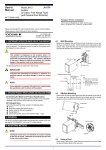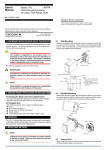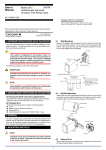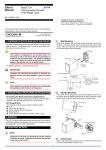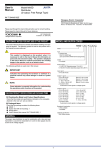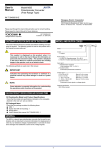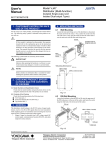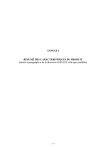Download User`s Manual
Transcript
User’s Manual Model JM12 Isolator (2-output, mV Input Free Range Type) IM 77J03M01-02E Network Solutions Business Divisiion 2-9-32, Naka-cho Musashino-shi, Tokyo 180-8750 Japan Phone: +81-422-52-7179 Facsimile: +81-422-52-6793 Please read through this User’s Manual before use for correct handling. Please keep this User’s Manual for future reference. IM 77J03M01-02E 1st Edition Apr. 2004 (YK) 2nd Edition May 2004 (YK) 1. CAUTIONARY NOTES FOR SAFE USE OF THE PRODUCT 4.1 Wall Mounting Remove the stoppers (top and bottom) from the product and pull out the main unit from the socket. Fix the socket on the wall using two M4 screws. Next, insert the main unit into the socket and fasten the main unit with the stoppers (top and bottom). This User’s Manual should be carefully read before installing and operating the product. The following symbol is used on the product and in this manual to ensure safe use. Stopper This symbol is displayed on the product when it is necessary to refer to the User’s Manual for information on personnel and instrument safety. This symbol is displayed in the User’s Manual to indicate precautions for avoiding danger to the operator, such as an electric shock. Main unit Socket Mounting screws The following symbols are used only in this manual. IMPORTANT Indicates that operating the hardware or software in a particular manner may cause damage or result in a system failure. [Mounting Dimensions] Pitch: 56 or more Socket Unit: mm 5 or more 2-4.5 or 2-M4 (85) NOTE Draws attention to essential information for understanding the operations and/or functions of the product. Note: (1) More than 5 mm interval is required for side-by-side close mounting. (2) Use the supplied spacer for DIN rail mounting to keep 5 mm interval. 400.2 (51) 2. CHECKING PRODUCT SPECIFICATIONS AND PACKAGED ITEMS 4.2 DIN Rail Mounting Insert a DIN rail into the upper part of the DIN rail groove on the rear of the socket, and then slide the slide lock at the lower part of the socket upwards until the socket is fixed into position as shown below. (1) Checking the Model and Product Specifications Check that the model and specifications indicated on the nameplate attached to the front face of the main unit are as ordered. (2) Packaged Items Fit into here Check that the packing carton contains the following items: ● JM12: 1 ● Spacer (used for DIN rail mounting): 1 ● Range labels: 2 ● User’s Manual (this manual: IM 77J03M01-02E): 1 copy DIN rail Push 3. GENERAL DIN rail The JM11 is a plug-in type isolator that converts mV DC voltage signals into isolated DC current or DC voltage signals. (Rear of socket) 4. MOUNTING METHOD NOTE Spacer Insert/pull out the main unit into/from the socket vertically to the face of socket. Otherwise the terminals are bent and it may cause a bad contact. Slide lock 4.3 Using a Duct When using a wiring duct, install the duct at leaset 20 mm away from the top and bottom faces of the main unit. 1 5. INSTALLATION LOCATIONS 7. PART NAMES OF FRONT PANEL ● Avoid the following environments for installation locations: Areas with vibration, corrosive gases, dust, water, oil, solvents, direct sunlight, radiation, a strong electric field, and/or a strong magnetic field ● If there is any risk of a surge being induced into the power line and/or signal lines due to lightning or other factors, a dedicated lightning arrester should be used as protection for both this unit and a field-installed device. The figure below shows the JM12 with its front panel (cover) being open. Communication connector Operation indicating lamp Selection switch Adjustment switch 6. EXTERNAL WIRING WARNING To avoid the risk of an electric shock, turn off the power supply and use a tester or similar device to ensure that no power is supplied to a cable to be connected, before carring out wiring work. 7.1 Operation Indicating Lamp The operation indicating lamp shows the operating status, abnormal setting, and adjustment operating status using the adjustment switch on the front panel. (1) When the lamp is lit: Power is turned on and the distributor is in the normal status provided that the selection switch is turned to the position “0.” (2) When the lamp is flashing rapidly: The lamp repeats the rapid flashing until the internal processing is completed during output adjustments and the wiring resistance correction using the adjustment switch. (3) When the lamp is flashing slowly: The lamp repeats the slow flashing until the distributor regains its normal status when the following abnormalities occur. ● Abnormal parameter setting ● The selection switch is turned to the positions other than “0.” ● Input is out of the range of -10 to 110%. Wiring should be connected to the terminals on the socket of the product. The terminals for external connections are of M3.5 screws. Use crimp-on terminal lugs for connections to the terminals. ● Recommended cables: A nominal cross-sectional area of 0.5 mm2 or thicker for signal cables, and that of 1.25 mm2 or thicker for power cables. Power Supply L N GND Input 7 8 8 7 6 5 6 5 9 4 9 3 Output-2 10 11 Output-1 10 11 1 2 1 2 7.2 Communication Connector The communication connector is used when setting the parameters through a PC (VJ77 Parameter Setting Tool) or the Handy Terminal. IMPORTANT JHT200 Handy Terminal ● The power line and input/output signal lines should be installed away from noise-generating sources. Other wise accuracy cannot be guaranteed. ● The grounding resistance must be 100 Ω (JIS Class D grounding). The length and thickness of the grounding cable should be as short and thick as possible. Directly connect the lead from the ground terminal (terminal no. 9) of the product to the ground. Do not carry out daisychained inter-ground terminal wiring. ● Use of the product ignoring the specifications may cause overheating or damage. Before turning on the power, ensure the following: (a) Power supply voltage and input signal value applied to the product should meet the required specifications. (b) The external wiring to the terminals and wiring to ground are as specifications. ● Do not operate the product in the presence of flammable or explosive gases or vapors. To do so is highly dangerous. ● The product is sensitive to static electricity; exercise care in operating it. Before you operate the product, touch a nearby metal part to discharge static electricity. JUXTA communication cable with 5-pin connectors (F9182EE) [Provided with VJ77, JHT200] Modular jack conversion adapter (E9786WH) [Provided with VJ77] Dedicated adapter (E9789HA) [Provided with VJ77] Dedicated cable (E9786WK) [Provided with VJ77] PC 7.3 Selection Switch and Adjustment Switch The following adjustments can be made using the switches on the front panel (selection switch and adjustment switch) without the dedicated setting tool (see Section 7.2, "Communication Connector"). The adjusted value is stored about 1 second after operating the adjustment switch. Also when the rotating direction of the adjustment switch is changed, the adjusted value becomes effective about 1 second after the change. Position of selection switch 0 1 2 3 4 5 Items to be adjusted No function Zero adjustment of output-1 Span adjustment of output-1 Zero adjustment of output-2 Span adjustment of output-2 Wiring resistance correction Rotating direction of adjustment switch Action to be adjusted Increase of output adjusted value and Clockwise execution of wiring resistance correction Decrease of output adjusted value and Counterclockwise reset of wiring resistance corrected value 2 IM 77J03M01-02E 2nd Edition May 21, 2004-00 8.3 [Adjusted volume by adjustment switch] One%álick changes about 0.005% of the output range. 7.3.1 Adjusting output using the switches on the front panel (1) Zero adjustment of output Turn the selection switch to “1.” Rotate the adjustment switch clockwise to increase the output, and counterclockwise to decrease the output. (2) Span adjustment of output Turn the selection switch to “2.” Rotate the adjustment switch clockwise to increase the output, and counterclockwise to decrease the output. Output 2 can be adjusted by the same operations as above. (3) Zero adjustment of output-2 Turn the selection switch to “3.” An adjustment switch adjusts. (4) Span adjustment of output-2 Turn the selection switch to “4.” An adjustment switch adjusts. 9. MAINTENANCE The product starts running immediately when the power is turned on; however, it needs 10 to 15 minutes of warm-up before it meets the specified performance. 9.1 ● ● ● ● 7.3.2 Correcting wiring resistance using the switches on the front panel When an error occurs due to the influence of the input wiring resistance, perform the wiring as the figure below, apply a stable input, and execute the following operations. Then the wiring resistance can be corrected automatically. Voltage generator Correcting Wiring Resistance Correct the wiring resistance in [P01:WIRING R]. Select “EXECUTE” for correction, and “RESET” for resetting the corrected value. Perform wiring as the figure shown in Subsection 7.3.2, “Correcting wiring resistance using the switches on the front panel” before correcting wiring resistance. 9.2 Calibration Apparatus A DC voltage/current standard (Yokogawa 7651 or the equivalent) A digital mutimater (Yokogawa 7561 or the equivalent) A precision resistor of 250 ± 0.01%, 1 W A setting tool for adjustment (See Section 7.2, “Communication Connector.”) Calibration Procedure (1) Connect the instruments as shown below. First adjust the output-1 signal and then the output-2 signal. (2) Use the DC voltage/current standard and apply input signals equivalent to 0, 25, 50, 75, and 100% of the input span to the isolator. (3) Check to see the corresponding output voltages are 0, 25, 50, 75, and 100% respectively and within the specified accuracy rating. “R” is used for current output. ● If the output signals are out of the accuracy rating range, adjust the output signal level through a setting tool (VJ77 Parameter Setting Tool or JHT200 Handy Terminal), or using the selection switch and adjustment switch on the front panel. For adjustment through a setting tool, see each user's manual of setting tool, and Chapter 10, “List of Parameters.” For adjustment using the switches on the front panel, see Section 7.3, “Selection Switch and Adjustment Switch.” VJ77 user's manual: “VJ77 PC-based Parameter Setting Tool” (IM 77J01J77-01E) JHT200 user's manual: “JHT200 Handy Terminal” (IM JF81-02E). JM12 Two signal lines are connected to the same terminal of one side. Be sure to rotate the adjustment switch counterclockwise to reset the corrected value before executing the wiring resistance correction. (1) Executing the wiring resistance correction Turn the selection switch to “5”, and rotate the adjustment switch clockwise. Then the wiring resistance is adjusted after 1 second automatically. (2) Resetting the wiring resistance corrected value Turn the selection switch to “5”, and rotate the adjustment switch counterclockwise. Then the adjusted value is reset after 1 second. NOTE Power supply L ● Make sure to turn the selection switch back to the position "0" after each adjustment. The positions other than "0" mean the adjustment modes, and it may cause a wrong operation. ● When the selection switch is turned to the positions other than "0", setting through the setting tool is impossible. N GND 7 Input 8 8 7 6 5 9 4 9 Output-1 10 R 11 8. SETTING PARAMETERS Digital multimater R: 250 precision resistor for current output Set the parameters through a PC (VJ77 Parameter Setting Tool) or the Handy Terminal. For details how to set, see Chapter 10, “List of Parameters”, User’s manual “VJ77 PC-based Parameter Setting Tool” (IM 77J01J77-01E), or User’s manual “JHT200 Handy Terminal” (IM JF81-02E). The description in the [ ] indicates the parameters. 5 6 DC voltge/ current standard 3 10 11 1 Output-1 2 1 R 2 Digital multimater R: 250 precision resistor for current output NOTE ● Changing the input range and the burnout action direction resets the input adjusted value and the wiring resistance corrected value. ● Execute the wiring resistance correction when the burnout action direction or input wiring is changed. 8.1 Setting Input Range Set the input range 0% in [D27:INPUT1L_RNG], and the input range 100% in [D28:INPUT1H_RNG]. Setting range: Within -60 to +240 mV DC, 3 mV of span minimum 8.2 Setting Burnout Action Set the burnout action in [D43:BURN OUT]. Set "OFF", "UP", or "DOWN." 3 IM 77J03M01-02E 2nd Edition May 21, 2004-00 10. LIST OF PARAMETERS Parameter Display MODEL Item Model TAG NO SELF CHK Tag number Self-check result A DISPLAY1 Display1 A01 A07 INPUT1 OUTPUT1 Input-1 Output-1 A08 OUTPUT2 Output-2 A54 A56 STATUS REV NO Status *1 A58 MENU REV A60 B SELF CHK DISPLAY2 B01 INPUT1 B07 B08 OUTPUT1 OUTPUT2 B60 SELF CHK D D01 SET (I/O) TAG NO.1 D02 D03 TAG NO.2 COMMENT1 Tag number-2 Comment-1 D04 COMMENT2 Comment-2 D13 D27 D28 LINEARIZE INPUT1 L_RNG INPUT1 H_RNG Linearize *2 D38 D39 OUT1 L_RNG OUT1 H_RNG Output-1 low range *2 D40 D41 D43 OUT2 L_RNG OUT2 H_RNG BURN OUT Output-2 low range *2 D49 D50 D60 OUT1 DR OUT2 DR SELF CHK P P01 P02 P03 ADJUST WIRING R IN1 ZERO ADJ IN1 SPAN ADJ P26 P27 P28 P29 P60 Q Q03 Q04 Q60 OUT1ZERO ADJ OUT1SPAN ADJ OUT2ZERO ADJ OUT2SPAN ADJ SELF CHK TEST OUT1 TEST OUT2 TEST SELF CHK *1 *2 *3 REV No. MENU REV Self-check result Display2 Input-1 Output-1 Output-2 Self-check result Setting (I/O) *3 Tag number-1 Input low range Input high range Output-1 high range *2 Output-2 high range *2 Burnout Direction of output-1 action Direction of output-2 action Self-check result Adjustment *3 Wiring resistance correction Zero adjustment of input-1 Span adjustment of input-1 Zero adjustment of output-1 Span adjustment of output-1 Zero adjustment of output-2 Span adjustment of output-2 Self-check result Test *3 Forced output-1 Forced output-2 Self-check result The displayed status is to let the service staff know the past records of the product. The parameters are the items to be set at the factory. Execute the following operations when indicating "D**", "P**", or "Q**" through JHT200 Handy Terminal. Press <F1>key, [ ] key, and <ENTER> key, in this order. Enter D, P, or Q in [ ]. 4 IM 77J03M01-02E 2nd Edition May 21, 2004-00






